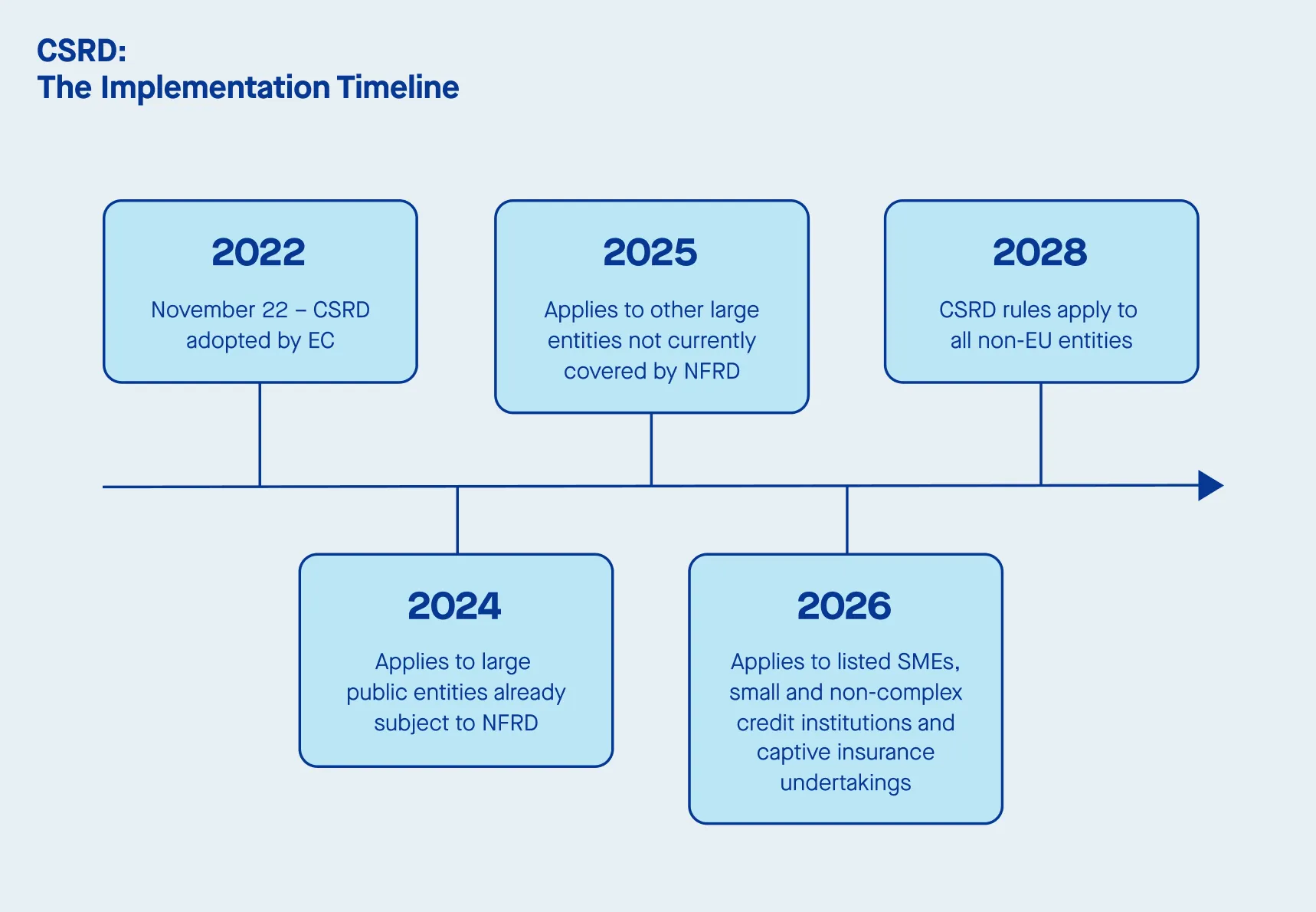The Corporate Sustainability Reporting Directive (CSRD) is set to significantly impact businesses operating in the European Union (EU). With its introduction, companies of all sizes will face new, stringent sustainability reporting requirements, driving transparency in their environmental, social, and governance (ESG) practices. Whether your company is EU-based or a non-EU business with operations within the EU, complying with the CSRD directive will be a key concern in 2024.
The directive introduces complex reporting standards, particularly around sustainability reporting processes and sustainability data management, which may be challenging for companies to manage. Fortunately, several software solutions can streamline these processes, easing the compliance burden. This article reviews the top five CSRD software platforms of 2024, designed to help companies meet their sustainability reporting obligations while enhancing their ESG efforts.
Understanding the CSRD – A quick recap
The Corporate Sustainability Reporting Directive (CSRD) is a new regulatory framework introduced by the European Union aimed at enhancing the transparency of corporate sustainability reporting. Replacing the Non-Financial Reporting Directive (NFRD), the CSRD significantly expands the scope and depth of ESG (environmental, social, and governance) disclosures required from businesses. Under this directive, companies must report on how sustainability factors such as climate change, social responsibility, and corporate governance impact their operations, while also detailing how their activities affect society and the environment. This includes the concept of double materiality, requiring businesses to assess both financial and environmental impacts.
The CSRD applies to a broader range of companies than its predecessor, impacting not only large corporations but also listed small and medium-sized enterprises (SMEs) and non-EU companies with significant operations in Europe. It introduces the European Sustainability Reporting Standards (ESRS), which set detailed guidelines for reporting on various sustainability metrics, from carbon emissions to human rights. These enhanced reporting obligations are designed to improve transparency, promote sustainable business practices, and help drive the EU’s broader green transition.
The CSRD compliance timeline
The implementation of the CSRD begins in January 2024, affecting different types of companies over several years. Here’s a breakdown of the timeline and the businesses impacted:
- 2024: Large companies already subject to the Non-Financial Reporting Directive (NFRD) must comply with CSRD requirements, with the first reports due in 2025.
- 2025: Large companies not previously covered by NFRD, with more than 250 employees, €50 million in turnover, or €25 million in assets, must start reporting.
- 2026: Small and medium-sized enterprises (SMEs) listed on EU-regulated markets with over 10 employees or more than €900,000 in turnover must comply.
- 2028: Non-EU companies with significant operations in the EU, meeting certain turnover and presence thresholds, will be required to report under the CSRD.
As CSRD reporting becomes mandatory, businesses need to ensure they are prepared for these deadlines by establishing robust systems to manage their sustainability efforts and regulatory compliance.

Data requirements for CSRD compliance
CSRD compliance hinges on gathering comprehensive and accurate sustainability data, particularly through the lens of double materiality. This concept requires companies to assess not only how sustainability factors affect their business but also how their operations impact the environment and society. A materiality assessment helps identify the ESG issues most relevant to a company and its stakeholders.
To comply with the CSRD directive, companies must track and report data on various sustainability metrics, including:
- Carbon footprints for Scope 1, 2, and 3 emissions.
- ESG risks and opportunities within the business model.
- Impacts on climate, biodiversity, water resources, and other environmental factors.
- Supply chain risks and opportunities related to sustainability.
Given the complexity and scope of these reporting needs, specialized software platforms are essential for accurate and comprehensive data tracking and reporting.
Common CSRD data challenges
Complying with the CSRD directive introduces several data-related challenges for businesses as they navigate complex sustainability reporting processes.
1. Gathering accurate emissions data
One of the key challenges for companies is collecting and reporting accurate emissions data, especially when tracking Scope 1, 2, and 3 GHG emissions. Many businesses struggle with understanding the full extent of their carbon management responsibilities, particularly when it comes to emissions from their value chains. This often leads to gaps in reporting and makes it difficult to ensure accuracy. Implementing robust data collection methods and using the right software solutions can help.
2. Meeting evolving regulatory requirements
As the CSRD directive comes into effect, businesses must stay up to date with the constantly evolving regulatory requirements. The scope and complexity of these requirements mean that companies must track various ESG factors while ensuring their data meets the necessary standards for audit proof documentation. This includes conducting gap assessments and maintaining a clear audit trail to provide evidence of compliance during reviews. Managing this regulatory landscape requires software platforms that can streamline compliance and offer real-time updates.
3. Ensuring data quality and audit readiness
Ensuring the quality and completeness of sustainability data, while maintaining audit readiness, is another major challenge. Poor data governance, coupled with inefficient systems for data validation, can lead to inconsistencies or errors in reporting. Businesses must ensure their data is accurate, verifiable, and easy to trace, creating an audit trail that supports all reported metrics. Establishing processes that ensure data integrity across various ESG metrics, from carbon accounting to social factors, is critical for producing audit-proof reports and avoiding compliance issues.
How software can help with CSRD compliance
CSRD software platforms are designed to ease the burden of compliance and ensure companies are well-prepared to meet new reporting requirements. Here’s how these solutions assist businesses:
- Data automation: Automating data processes reduces manual work, enhancing transparency and minimizing the risk of errors.
- Materiality assessments: Software solutions help businesses conduct double materiality assessments, identifying critical ESG issues to address.
- Gap assessment: Software platforms can identify missing information, helping companies refine their sustainability data management practices.
- Audit readiness: Most platforms provide robust audit trails, ensuring data integrity and simplifying regulatory reviews.
- Collaboration tools: Software enhances communication and collaboration across teams and with external stakeholders, improving the efficiency of sustainability reporting processes.
Next, we will review the top five CSRD software platforms of 2024 that offer strong support for managing sustainability data and reporting obligations.
Key features of CSRD software platforms
CSRD software platforms are essential tools designed to simplify the sustainability reporting process, ensuring compliance with the European Sustainability Reporting Standards (ESRS). These platforms offer several key features that streamline and enhance the reporting process:
- Data collection and management: These platforms streamline the collection and organization of sustainability data, making it easier for companies to report on various ESG metrics. Efficient data management ensures that all relevant information is accurately captured and readily available for reporting.
- Double materiality assessments: A critical feature of CSRD software is the ability to conduct double materiality assessments. This process helps identify the most significant sustainability issues that need to be reported, ensuring that companies focus on the most material topics that impact both their business and the environment.
- Sustainability performance tracking: Monitoring and analyzing sustainability performance is crucial for continuous improvement. CSRD software platforms provide tools to track performance across various sustainability indicators, enabling companies to make informed decisions and drive improvements in their sustainability efforts.
- Reporting and disclosure: Generating reports that meet CSRD reporting requirements is a core function of these platforms. They ensure that companies can produce transparent and accountable reports that comply with the European Sustainability Reporting Standards.
- Gap analysis: Identifying areas for improvement in sustainability reporting is essential for continuous enhancement. CSRD software platforms offer gap analysis tools that help companies pinpoint deficiencies in their reporting processes and develop strategies to address them.
By leveraging these key features, companies can streamline their sustainability reporting processes, ensure compliance with CSRD requirements, and enhance their overall sustainability performance.
Top 5 CSRD software platforms
When navigating the complexities of CSRD compliance, having the right software platform is essential to streamline ESG data management and reporting. The following top five CSRD software platforms offer good support and robust tools to help ensure compliance with evolving sustainability regulations.
1. Sweep – CSRD reporting made simple
Sweep offers an all-in-one platform that simplifies the complexities of CSRD reporting, allowing businesses to automate their processes and streamline collaboration across teams.
- Materiality assessment: Conduct a double materiality assessment tailored to your industry, focusing on critical sustainability topics like financial impact and impact thresholds.
- Gap assessment and data: Automate gap analysis and stakeholder engagement through surveys and file imports, improving governance by defining clear roles.
- Data validation: Sweep’s advanced workflow helps validate or reject data points, ensuring consistency and accuracy in sustainability reports.
- Audit readiness: Maintain detailed audit trails, correct data inconsistencies, and track changes across the platform.
- CSRD reporting: Compile and export material indicators in the required format, ensuring compliance with European Sustainability Reporting Standards (ESRS).
Why Sweep?
Sweep is ideal for large companies managing complex sustainability data, offering robust tools for streamlining the entire reporting process, from gap assessments to submission.
2. Watershed – Take control over ESG data management
Watershed provides an intuitive platform designed to meet the data needs of CSRD compliance, offering tools for tracking, managing, and validating sustainability data across an organization’s value chain.
- Materiality assessments: Watershed’s report builder enables businesses to perform double materiality assessments and centralize complex data inputs.
- Risk assurance: Built-in governance tools ensure data meets strict audit standards, allowing companies to give auditors direct access to view data lineage and evidence.
- Expert support: Watershed’s team of environmental scientists and policy advisors provide guidance on answering complex ESG questions and ensuring reliable metrics.
Why Watershed?
Watershed’s expert-driven platform and strong governance tools make it a solid choice for companies needing real-time collaboration and oversight to ensure smooth sustainability reporting processes.
3. Greenly – Simplifying double materiality and ESG reporting
Greenly is an AI-driven platform that helps businesses manage their CSRD compliance, with a focus on double materiality assessments and streamlined ESG data management.
- Materiality assessment: Use Greenly’s AI to map your value chain, assess climate risks, and define material topics, supported by certified implementation partners.
- Gap assessment and data integration: Conduct gap analysis and simplify data integration to ensure alignment with ESRS guidelines.
- Environmental reporting: Greenly supports comprehensive reporting on environmental factors like climate change, biodiversity, pollution, and the circular economy.
- Audit readiness: Collaborate with internal and external experts to ensure high-quality results and streamline audit processes.
Why Greenly?
Greenly’s AI-powered platform is ideal for businesses looking for an advanced, user-friendly tool to manage materiality assessments and sustainability reporting.
4. Greenomy – Simplify ESG compliance, maximize impact
Greenomy helps companies simplify the collection and management of sustainability data, making it easier to meet CSRD and EU taxonomy requirements.
- Simplified data management: Greenomy automates much of the data collection and verification process, enhancing efficiency in reporting.
- Autonomy in reporting: Businesses gain control over their ESG reporting, driving strategic changes while maintaining compliance with the CSRD directive.
- AI-driven efficiency: Greenomy’s AI capabilities reduce the time spent on data processes, enabling companies to focus on enhancing sustainability efforts.
Why Greenomy?
Greenomy is well-suited for companies seeking to enhance transparency and streamline ESG compliance through automation and AI-driven reporting tools.
5. Coolset – Empowering SMEs for sustainable growth
Coolset is an Amsterdam-based platform designed to help SMEs track, reduce, and eliminate carbon emissions while fast-tracking their CSRD compliance.
- Carbon footprints: Measure Scope 1, 2, and 3 emissions, identifying hotspots and providing sustainable alternatives.
- CSRD module: Coolset’s dedicated CSRD module simplifies the process, offering tools for materiality assessments and tailored reporting.
- Support for SMEs: Built for startups and mid-market companies, Coolset provides an accessible platform for businesses managing their first CSRD compliance cycles.
Why Coolset?
Coolset is ideal for SMEs looking for a flexible, easy-to-use software solution that combines carbon accounting with streamlined CSRD reporting.
Implementation best practices
Implementing CSRD software platforms requires careful planning and consideration of several factors to ensure successful adoption and maximize the benefits of CSRD compliance. Here are some best practices to follow:
- Data quality and accuracy: Ensuring that sustainability data is accurate, reliable, and consistent is paramount. Companies should establish robust data governance practices to maintain high data quality, which is essential for credible and audit-proof reporting.
- Stakeholder engagement: Involving stakeholders in the sustainability reporting process is crucial. Engaging with stakeholders helps address their concerns and expectations, ensuring that the reported information is relevant and comprehensive.
- Integration with existing systems: Integrating CSRD software with existing systems and processes minimizes disruption and ensures a seamless flow of data. This integration helps maintain consistency and efficiency in data management and reporting.
- Training and support: Providing adequate training and support to users is essential for maximizing the benefits of CSRD software platforms. Ensuring that users are comfortable with the software and understand its functionalities will lead to more effective and efficient use.
- Continuous monitoring and improvement: Regularly reviewing and improving sustainability reporting processes is vital for maintaining their effectiveness and efficiency. Companies should continuously monitor their reporting practices and make necessary adjustments to stay compliant and improve their sustainability performance.
Selecting the right CSRD software platform
Choosing the right software for CSRD compliance is crucial as businesses face evolving reporting requirements. The five platforms reviewed here offer powerful solutions to manage reporting, materiality assessments, carbon footprints, and audit readiness. Each software platform has its strengths, and the right choice will depend on your company’s size, industry, and specific needs. With the right tool in place, businesses can meet their CSRD obligations, ultimately driving more sustainable business practices and enhancing their sustainability reporting processes.




